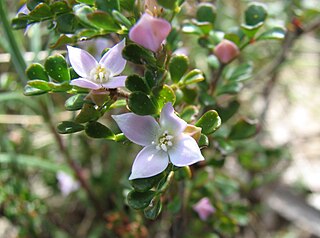
Boronia algida, commonly known as alpine boronia, is a flowering plant in the citrus family, Rutaceae and is endemic to south-eastern Australia. It is an erect shrub with many branches, pinnate leaves and white to bright pink, four-petalled flowers usually borne singly on the ends of branches.

Boronia forsteri is a plant in the citrus family Rutaceae and is endemic to mountain ranges in central Queensland, Australia. It is an erect shrub with many branches, simple leaves with a densely hairy, pale underside, and pink, four-petalled flowers.

Boronia lanceolata is a plant in the citrus family Rutaceae and is endemic to northern parts of the Northern Territory and Queensland. It is an erect shrub with many branches, elliptic to lance-shaped leaves and white or pink, four-petalled flowers. It is the most common boronia in the Northern Territory.
Boronia citrata, commonly known as lemon boronia, is a plant in the citrus family, Rutaceae and is endemic to Victoria. It is an erect, woody shrub with pinnate, strongly lemon-scented leaves and pale pink to rosy pink, four-petalled flowers arranged in groups of up to five.
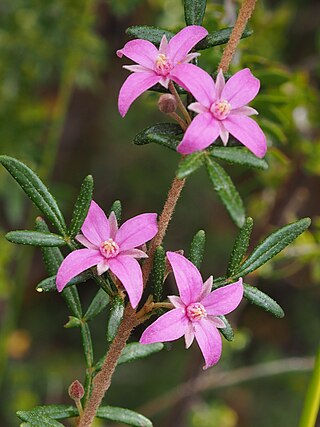
Cyanothamnus inflexus is a plant in the citrus family Rutaceae and is endemic to tablelands near the New South Wales - Queensland border in Australia. It is an erect, woody shrub with pinnate leaves and up to seven white to pink four-petalled flowers in the leaf axils. Boronia bipinnata is similar but has larger, bipinnate or tripinnate leaves and smaller sepals and petals.

Boronia laxa is a plant in the citrus family Rutaceae and is endemic to a small area in the Northern Territory, Australia. It is a low-lying, short-lived shrub with hairy branches, leaves and flower parts, simple leaves and white to mauve flowers with the sepals longer and wider than the petals.
Boronia minutipinna is a plant in the citrus family Rutaceae and is endemic to a small area in the Kimberley region of Western Australia. It is an erect shrub with many branches, hairy stems and leaves, pinnate leaves and white to pink, four-petalled flowers with the sepals longer and wider than the petals.

Boronia parviflora, commonly known as the swamp boronia, small boronia, tiny boronia, or small-flowered boronia, is a plant in the citrus family Rutaceae and is endemic south-eastern Australia. It is a weak, low shrub with elliptic to egg-shaped leaves with finely toothed edges and up to three pink, white or green four-petalled flowers arranged at or near the ends of the stems.

Cyanothamnus polygalifolius, commonly known as dwarf boronia, milkwort-leaved boronia or milkwort boronia, is a plant in the citrus family Rutaceae and is endemic to eastern Australia. It is a low-lying shrub with simple leaves and white or pink flowers arranged singly or in groups of up to three in leaf axils.

Boronia prolixa is a species of plant in the citrus family Rutaceae and is endemic to a small area in the Northern Territory, Australia. It is a low-lying shrub with hairy branches, leaves and flower parts, simple leaves and white to pink flowers with the sepals longer and wider than the petals.
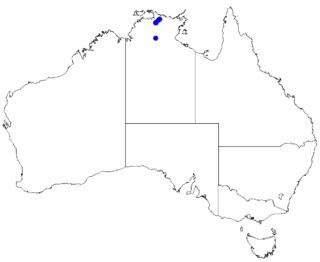
Boronia rupicola is a species of plant in the citrus family Rutaceae and is endemic to a small area in the Northern Territory, Australia. It is a small shrub with weeping branches, simple or pinnate leaves and small, green, inconspicuous flowers.

Boronia splendida is a species of plant in the citrus family, Rutaceae, and is endemic to Queensland, Australia. It is an erect shrub with most parts covered with star-like hairs and has simple, linear to narrow elliptic leaves, and pink to white, four-petalled flowers.

Boronia squamipetala is a species of plant in the citrus family, Rutaceae, and is endemic to Queensland, Australia. It is an erect shrub with pinnate leaves with between five and thirteen elliptic leaflets, and green to white, four-petalled flowers with hairy backs.
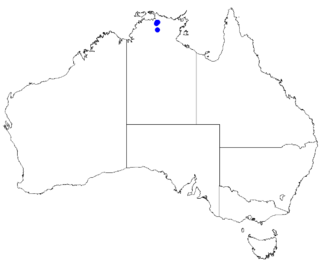
Boronia suberosa is a species of plant in the citrus family Rutaceae and is endemic to a small area in the Northern Territory, Australia. It is a shrub with weeping branches, simple leaves, and flowers with four small, white petals.
Boronia thedae, commonly known as the Theda boronia, is a plant in the citrus family, Rutaceae and is endemic to a small area in the Kimberley region of Western Australia. It is an erect shrub when young, later a prostrate shrub with many branches, pinnate leaves, four white to cream-coloured or pale pink sepals and four similarly coloured petals, the sepals longer and wider than the petals.

Boronia tolerans is a plant in the citrus family, Rutaceae and is endemic to a small area in the Northern Territory in Australia. It is an erect shrub with many branches, pinnate leaves and white, four-petalled flowers. It is only known from Nitmiluk National Park.

Boronia wilsonii is an erect shrub that is endemic to northern Australia. Its branches, leaves and backs of the flowers are densely covered with woolly hairs. The petals are white to pink or burgundy-coloured.

Boronia verecunda is a species of small, erect shrub that is endemic to a small area in the Northern Territory. The flowers are borne singly in leaf axils and are white or pink but turn green as the fruit matures. It is similar to B. xanthastrum.

Cyanothamnus warangensis is a species of erect, woody shrub that is endemic to Queensland. It has bipinnate leaves and groups of between five and twenty-five or more white flowers in leaf axils.
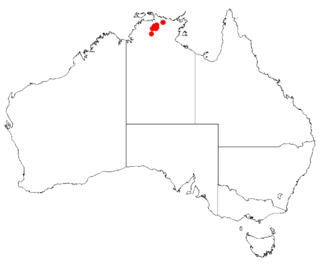
Boronia xanthastrum is a species of small shrub that is endemic to the Northern Territory. It has yellow, star-like hairs on the young branches, leaves and parts of the flowers, elliptical to lance-shaped leaves and small yellowish green flowers.
















